Simple stretching exercises can help you manage anxiety by releasing physical tension and calming your mind. Start with gentle neck rolls and shoulder circles while focusing on deep breathing. You'll find relief through basic standing poses like forward folds and side stretches, or try seated movements at your desk for quick stress relief. Before bed, practice calming poses like child's pose or legs-up-the-wall to promote relaxation and better sleep. Build these stretches into your daily routine, starting with just 5-10 minutes. The more you understand about the mind-body connection, the better equipped you'll be to tackle anxiety naturally.
Understanding Anxiety and Physical Tension
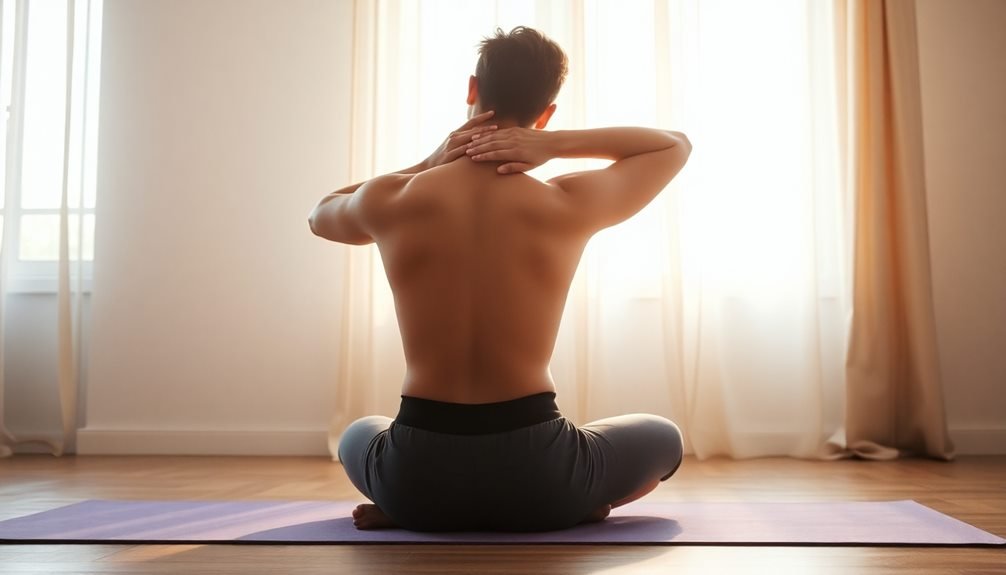
Many people experience anxiety as both a mental and physical response, with tension manifesting throughout the body in predictable patterns. When you're anxious, your muscles contract as part of your body's natural fight-or-flight response, leading to stiffness in your neck, shoulders, jaw, and back.
This physical tension can then feed back into your mental state, creating a cycle of increasing anxiety. You'll often notice that during periods of stress, you're unconsciously clenching your jaw, hunching your shoulders, or tightening your core muscles.
These physical reactions can result in headaches, muscle pain, and fatigue. Your breathing might also become shallow and rapid, reducing oxygen flow throughout your body and potentially intensifying your anxiety symptoms.
Understanding this mind-body connection is essential because it means you can use physical interventions, like stretching, to help break the anxiety cycle. By consciously releasing tension in your muscles, you're not just addressing the physical discomfort – you're also sending calming signals to your brain that can help reduce your overall anxiety levels.
Simple Neck and Shoulder Releases
When you're feeling anxious, your neck and shoulders often bear the weight of your stress through muscle tension and tightness.
You'll find relief through simple movements like neck rolls, shoulder circles, and upper back stretches that help release built-up tension.
These gentle exercises can be done anywhere, whether you're at your desk, in bed, or taking a quick break during your day.
Gentle Neck Rolls
Tension frequently builds up in the neck and shoulders during periods of anxiety, making gentle neck rolls an essential stretch for quick relief. You can perform this calming exercise while sitting or standing, but make sure you're maintaining good posture with your spine straight and shoulders relaxed.
Start by letting your chin drop toward your chest, feeling a gentle stretch along the back of your neck. Slowly roll your head to your right shoulder, maintaining a comfortable range of motion. Continue the rolling movement backward, but don't tilt your head too far back, as this can strain your neck. Then, roll toward your left shoulder and finally return to the starting position.
You'll want to complete this circular motion 3-5 times in each direction, moving slowly and breathing deeply throughout the exercise. If you experience any discomfort or dizziness, stop immediately.
Remember to keep the movement gentle and controlled – don't force your neck beyond its natural range. This stretch isn't just about physical release; it's also an opportunity to practice mindfulness as you focus on the sensation and rhythm of the movement.
Basic Shoulder Circles
Building on the benefits of neck rolls, shoulder circles offer another effective way to release upper body stress during anxious moments. This gentle movement helps loosen tight muscles and can reduce the physical tension that often accompanies anxiety.
To perform shoulder circles, start by sitting or standing with your spine straight and arms relaxed at your sides. Slowly roll both shoulders forward in a circular motion, making sure you're creating complete circles. Do this five times, then reverse the direction for another five circles. You'll feel the stretch across your upper back and shoulder blades.
If you're experiencing intense anxiety, you can modify this stretch by doing one shoulder at a time or making smaller circles. Focus on your breathing as you move, inhaling as your shoulders rise and exhaling as they lower. This coordination of breath and movement helps activate your body's relaxation response.
For maximum benefit, perform shoulder circles whenever you feel tension building – at your desk, while waiting in line, or during stressful situations. Remember to keep the movement fluid and gentle, never forcing beyond your comfort zone.
Upper Back Stretches
Upper back stretches provide instant relief when anxiety manifests as physical discomfort in your neck and shoulders. These gentle movements help release tension that builds up during stressful situations and can improve your overall posture.
Start by sitting comfortably in a chair with your feet flat on the floor. Cross your right arm over your chest, holding it with your left hand just above the elbow. Gently pull your right arm closer to your body, feeling the stretch across your upper back. Hold for 30 seconds, then switch arms.
Next, interlace your fingers behind your head. Keep your elbows wide and gently pull your head forward, bringing your chin toward your chest. You'll feel this stretch along your upper spine and between your shoulder blades. Hold for 15-20 seconds.
Calming Standing Stretches
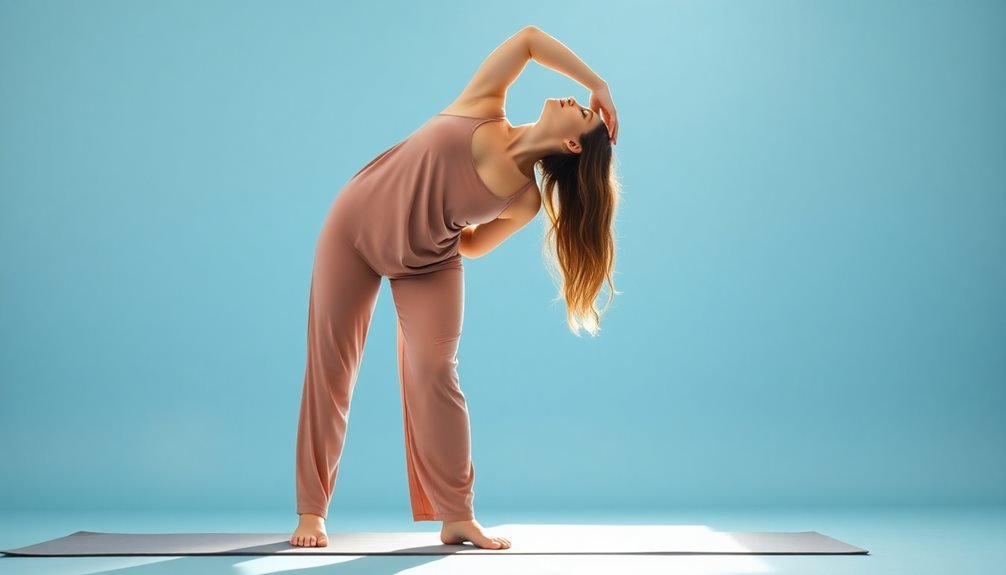
Standing stretches can help melt away anxiety while promoting better posture and breathing. You'll find these simple moves particularly effective when you're feeling overwhelmed at work or need a quick stress-relief break during your day.
Start with the mountain pose: stand tall with your feet hip-width apart, arms relaxed at your sides. Roll your shoulders back, and lift your chest while keeping your chin parallel to the floor. Take five deep breaths here, feeling your feet root into the ground.
Next, try forward folds: bend forward from your hips, letting your arms and head hang heavy. Don't lock your knees; keep a slight bend to avoid strain. This position naturally calms your nervous system and releases tension in your neck and spine.
For a gentle side stretch, raise your right arm overhead and lean to the left, creating length along your right side. Hold for three breaths, then switch sides.
You can also try shoulder rolls: lift your shoulders to your ears, then circle them back and down. Repeat this movement slowly 5-10 times, coordinating with your breath to release upper body tension.
Seated Stress Relief Poses
When anxiety feels overwhelming, seated stretches offer a convenient way to find relief right at your desk or on the couch.
These gentle movements help release tension in your shoulders, neck, and back while promoting deeper breathing and mental clarity. You'll find these poses particularly helpful during stressful workdays or when you need a quick reset without drawing attention to yourself.
Start by sitting tall with your feet flat on the floor and your shoulders relaxed. As you move through each stretch, remember to breathe deeply and hold each position for 15-30 seconds. If you feel any pain, ease up or stop the stretch immediately.
- Seated cat-cow: Arch your back while looking up, then round your spine while looking down, moving with your breath
- Seated spinal twist: Place your right hand on your left knee, twist gently to the left, and repeat on the opposite side
- Forward fold: Drop your chin to your chest and let your upper body hang heavy over your legs
- Neck releases: Slowly roll your head from side to side, making half-circles from shoulder to shoulder
Bedtime Relaxation Stretches

Trouble sleeping due to racing thoughts? These gentle bedtime stretches can help calm your mind and prepare your body for restful sleep. Perform these movements slowly while focusing on deep, steady breathing.
Start with the child's pose – kneel on your bed and sit back on your heels, extending your arms forward. Hold for 30 seconds while breathing deeply. Next, try the legs-up-the-wall pose by lying on your back and extending your legs vertically against the wall. This pose naturally slows your heart rate and calms your nervous system.
| Stretch | Duration | Benefits |
|---|---|---|
| Child's Pose | 30 seconds | Releases back tension |
| Legs-up-the-wall | 2-5 minutes | Reduces anxiety |
| Supine Twist | 1 minute/side | Relaxes spine |
Building Your Daily Stretch Routine
A consistent stretching practice can transform occasional relief into lasting calm. You'll see the best results when you incorporate stretching into specific moments of your day, creating triggers that remind you to pause and breathe. Start with just 5-10 minutes and gradually build up to longer sessions as your body adapts and your schedule allows.
Choose times when you're naturally shifting between activities, such as right after waking up or before heading to bed. Listen to your body's signals and adjust the intensity of your stretches accordingly. Remember that consistency matters more than perfection – it's better to stretch gently for five minutes daily than to push yourself too hard once a week.
- Set a daily alarm on your phone as a stretching reminder until it becomes habitual
- Keep a yoga mat or comfortable space readily accessible in your home
- Track your progress in a wellness journal to stay motivated
- Partner with a friend for accountability and shared practice
Consider this routine a form of self-care rather than another task on your to-do list. As you establish these healthy patterns, you'll develop a stronger mind-body connection and better anxiety management skills.
Frequently Asked Questions
Can Stretching Make Anxiety Worse for Some People?
Yes, if you're stretching too intensely or holding your breath, you can increase tension and anxiety. You'll want to focus on gentle movements and proper breathing to avoid making your anxiety symptoms worse.
Should I Stretch Before or After Taking Anti-Anxiety Medication?
You'll want to consult your healthcare provider about timing your stretches with medication. Generally, you can stretch either before or after, but it's crucial to know how your specific medication affects you.
How Long Should I Hold Each Stretch to Get Anxiety Relief?
Hold each stretch for 15-30 seconds while you're breathing deeply. You'll want to repeat each stretch 2-3 times. Don't force or bounce the stretches – keep them gentle and steady for best anxiety relief.
Are There Any Stretches I Should Avoid During Panic Attacks?
During panic attacks, you'll want to avoid inverted positions or stretches that restrict breathing. Don't attempt complex poses or anything that makes you feel trapped. Stick to gentle, open stretches that let you breathe freely.
Can I Combine Breathing Exercises With These Anxiety-Relief Stretches?
Yes, you'll definitely benefit from combining breathing exercises with stretches. Take slow, deep breaths while you stretch, and you'll enhance both techniques' calming effects. It's a natural way to double your anxiety relief.
In Summary
You've now got the tools to start managing anxiety through gentle movement. By incorporating these stretches into your daily routine, you'll release physical tension and calm your mind. Remember to breathe deeply, move slowly, and listen to your body's needs. Start with just a few minutes each day, and you'll soon notice the difference in both your stress levels and overall well-being.
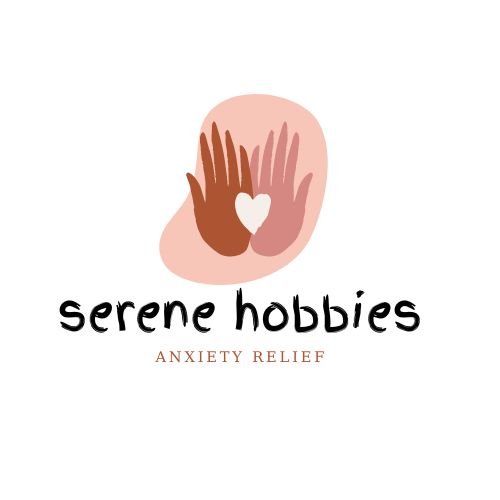
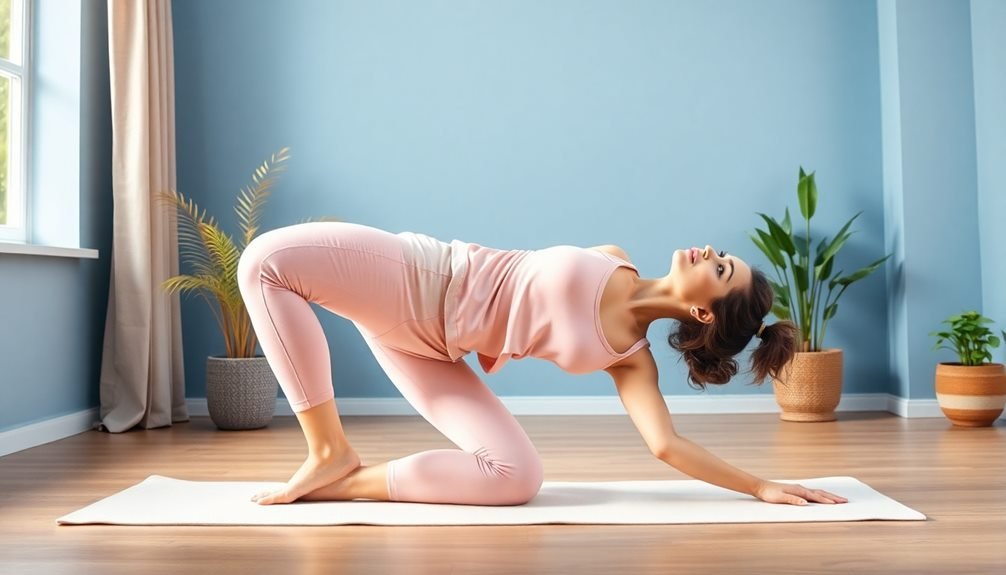
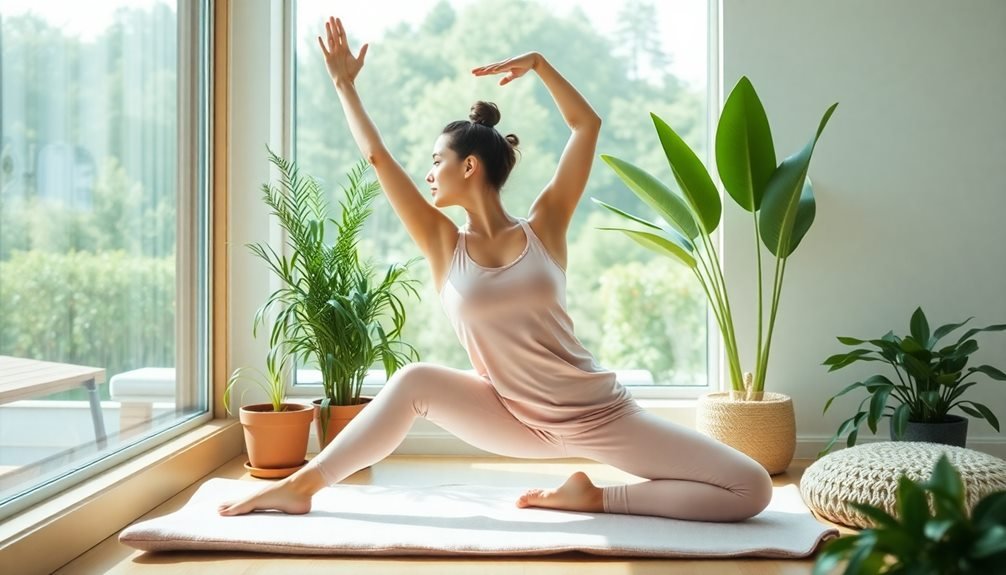
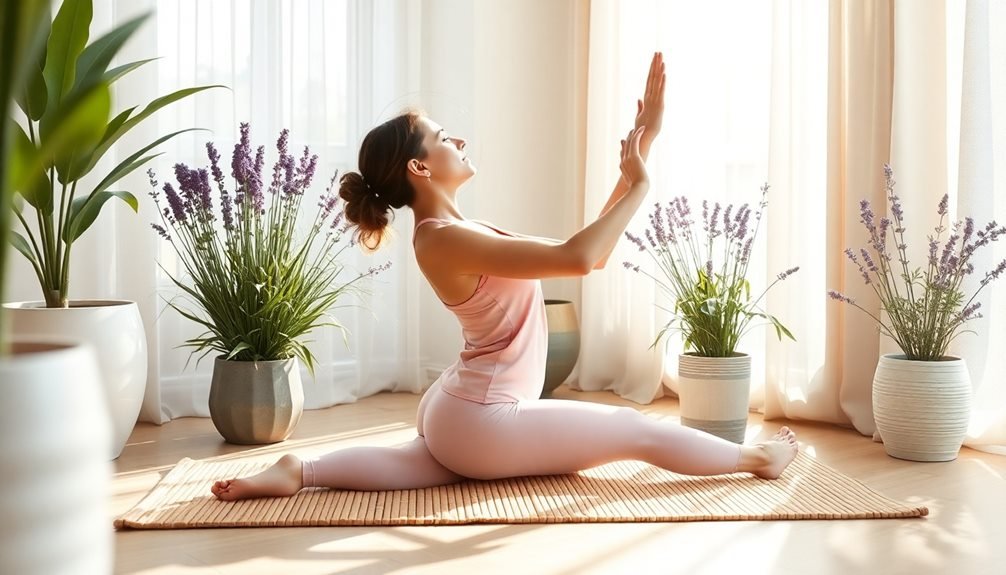
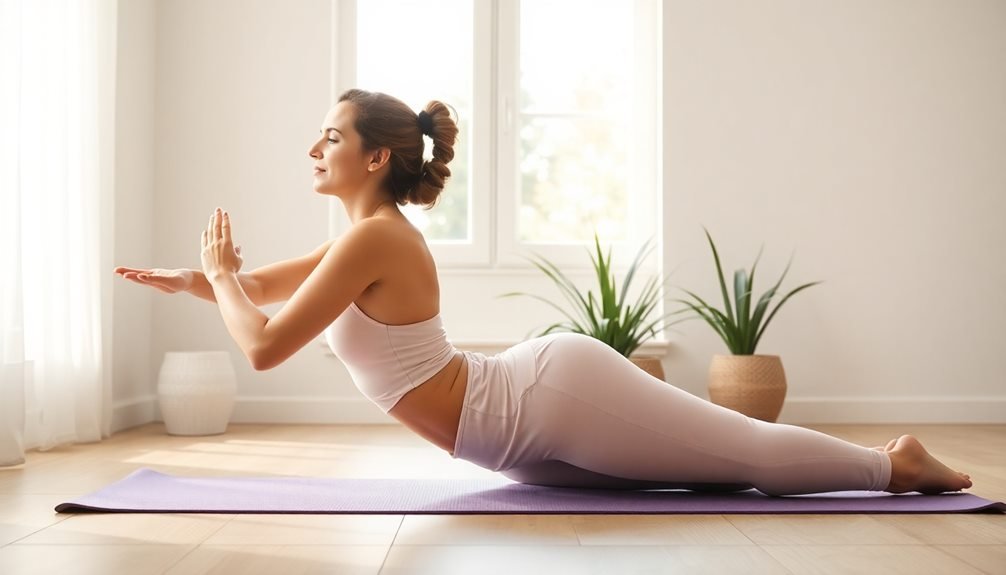
Leave a Reply